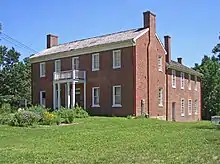Shawnee Methodist Mission
Shawnee Methodist Mission was established by missionaries in 1830 in Turner, Kansas to minister to the Shawnee tribe of Native Americans who had been removed to Kansas. In 1839 the mission relocated to Fairway, where it built a brick building referred to by names varying from Shawnee Indian Methodist Manual Labor School. It was one of the first such missions established in the territory acquired by the United States in the Louisiana Purchase. Designated as a National Historic Landmark in 1968, the Shawnee Methodist Mission is operated today as a museum. The site is administered by the Kansas Historical Society as the Shawnee Indian Mission State Historic Site.
Shawnee Mission | |
.jpg.webp) East Building in 1940 | |
| Location | 3403 W. 53rd Street, Fairway, Kansas |
|---|---|
| Coordinates | 39°1′59.2818″N 94°37′26.796″W |
| Area | 12 acres (4.9 ha) |
| Built | 1839 |
| NRHP reference No. | 66000345 |
| Significant dates | |
| Added to NRHP | October 15, 1966[1] |
| Designated NHL | May 23, 1968[2] |
The Shawnee Methodist Mission served briefly as the second capitol of the Kansas Territory, when the legislature was controlled by pro-slavery advocates,[3] holding that designation from July 16 to August 7, 1855.
The Shawnee Methodist Mission is the origin of the Shawnee Mission name used by the United States Postal Service to refer to the Kansas City Metropolitan Area suburban communities in northeastern Johnson County. The Shawnee Mission School District serves those communities.
The Shawnee
The "Fish" Shawnee tribe was removed from its traditional Ohio home to the unorganized territories set aside for Native Americans (in the future state of Kansas) under the terms of the Treaty of St. Louis (1825).[4] The mission was initially built on land near the American Shawnee Indian Tribe reserve in Turner by Reverend Thomas Johnson. He hoped to convert the recently relocated tribe to Christianity.
During the 1830s, some of the Shawnees' most venerated men, including Tenskwatawa "the Shawnee Prophet", frequently visited at the mission. The Prophet was the younger brother of Tecumseh, who had led a war against the United States earlier in the century. Tenskwatawa led the Shawnee in Tecumseh's absence at the Battle of Tippecanoe in 1811. Following defeat in this battle, Tenskwatawa took his men to the British Canadian colonies. He was placed under virtual house arrest for years following the end of the War of 1812. Tenskwatawa was eventually allowed to return to the Shawnee to help them remove from Ohio to Kansas; he died in 1836 at his village (the present site of Kansas City, Kansas).
The new mission
The mission was located at its original site from 1830 to 1839. In 1839, the mission was moved and built at its present-day Johnson County location, where an Indian boarding school was opened there. From 1839 until its closure in 1862, the Shawnee Mission served as a manual training school for Native Americans, principally from the Shawnee and Delaware tribes.
The Shawnee Mission also served as the second capital of the Kansas Territory. The capital was moved to the mission on July 16, 1855, after pro-slavery delegates to the Territorial Legislature voted to depart the first Territorial Capitol of Kansas at Pawnee. It served as territorial capital until August 8, when the seat of government became Lecompton.[5] While the capital was located at Shawnee Mission, the legislature promulgated the controversial pro-slavery laws that sparked Bleeding Kansas violence. During the American Civil War, the site served as a camp for Union soldiers.
The Shawnee Mission was declared a National Historic Landmark in 1968.[2]
Structures
 East Building, front
East Building, front East Building, back
East Building, back North Building
North Building West Building
West Building Conestoga wagon
Conestoga wagon East Building sign
East Building sign North Building sign
North Building sign West Building sign
West Building sign
References
- "National Register Information System". National Register of Historic Places. National Park Service. March 15, 2006.
- "Shawnee Mission". National Historic Landmark summary listing. National Park Service. Archived from the original on 2009-03-25. Retrieved 2008-06-28.
- History of Wyandotte County Kansas and its people, ed. and comp. by Perl W. Morgan. Chicago, The Lewis publishing company, 1911. (cf., "When the first territorial legislature met at Pawnee on July 2, 1855, at the order of Governor Reeder in a stone building erected for its use, it unseated the free state members, seated the pro-slavery men instead, and then passed a bill "to remove the capital temporarily to Shawnee Manual Labor School." It did this because the Shawnee mission was well known as a center of pro-slavery sympathy.")
- Shawnee treaty
- "Lecompton, Kansas". Civil War on the Western Front. The Kansas City Public Library. Retrieved April 2, 2017.
Further reading
- "Thomas Johnson's Story and the History of Fairway, Kansas". Joe H. Vaughan, Author, 2014. ISBN No. 978-63173-140-2. Two Trails Publishing Co., Inc., Independence, MO 64052.
External links
| Wikimedia Commons has media related to Shawnee Methodist Mission. |
- Official website
- Johnson County Museum, relocating and closed until June 10, 2017
- Shawnee Indian Mission history
- 1975 photos of North, East, and West Buildings
- 1940 HABS photo collection from Library of Congress. (Historic American Buildings Survey)